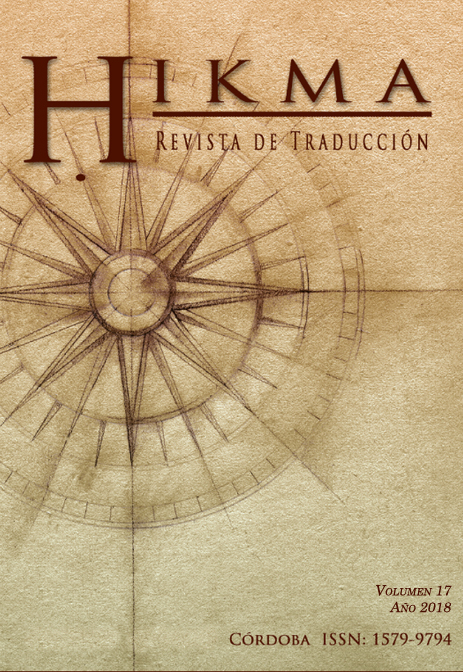Indexing a Gender Identity in Fictive Dialogue: Bucholtz and Hall’s Identity Principles in Translation
Main Article Content
Abstract
The framework for the analysis of identity construction proposed by Bucholtz and Hall (2005) has proved a useful heuristic tool for the study of identity formation in interaction. The aim of this article is to tentatively apply the model to fictive dialogue in translation and test its validity in two ways, firstly, as a framework for the descriptive analysis of identity formation in translation, and secondly, as a tool that can aid the translation of fictive dialogue.
The case study is Janice Angstrom, wife of the eponymous Harry Angstrom, in Updike’s «Rabbit» books. Using Bucholtz and Hall’s model, the descriptive analysis will compare the source and target texts for discursive mismatches that distort the intersubjective construction of her identity in interaction. The metapragmatic information yielded by the application of the model will then inform the proposed alternatives, guided by the principles of the model.
Downloads
Article Details

This work is licensed under a Creative Commons Attribution-NonCommercial-ShareAlike 4.0 International License.
Authors who publish with this journal agree to the following terms:
1. Authors retain copyright and grant the journal right of first publication with the work simultaneously licensed under a Creative Commons Attribution License that allows others to share the work with an acknowledgement of the work's authorship and initial publication in this journal.
2. Authors are able to enter into separate, additional contractual arrangements for the non-exclusive distribution of the journal's published version of the work (e.g., post it to an institutional repository or publish it in a book), with an acknowledgement of its initial publication in this journal.
3. Authors are permitted and encouraged to post their work online (e.g., in institutional repositories or on their website) prior to and during the submission process, as it can lead to productive exchanges, as well as earlier and greater citation of published work (See The Effect of Open Access).
References
Assis Rosa, A. (2015). Translating orality, recreating otherness. Translation Studies, 8(2), pp. 209-225. DOI: https://doi.org/10.1080/14781700.2015.1017833
Berman, A. (2000). Translation and the trials of the foreign. In Venuti, L. (Ed.), The Translation Studies Reader (pp.276-289). London and New York: Routledge.
Berthele, R. (2000). Translating African-American Vernacular English into German: the problem of “Jim” in Mark Twain’s Huckleberry Finn. Journal of Sociolinguistics, 4(4), pp. 588-613. DOI: https://doi.org/10.1111/1467-9481.00131
Boswell, M. (2001). John Updike’s Rabbit Tetralogy: Mastered Irony in Motion. Columbia: University of Missouri Press.
Brumme, J. (2012). Traducir la voz ficticia. Berlin and Boston: Walter de Gruyter. DOI: https://doi.org/10.1515/9783110263268
Brumme, J. and Espunya, A. (2012). The Translation of Fictive Dialogue. Amsterdam and New York: Rodopi. DOI: https://doi.org/10.1163/9789401207805
Bucholtz, M. and Hall, K. (2005). Identity and interaction: a sociocultural linguistic approach, Discourse Studies 7(4-5), pp.585-614. DOI: https://doi.org/10.1177/1461445605054407
De Bellis, J. (2000). The John Updike Encyclopedia. Westport, Connecticut and London: Greenwood Publishing Group. DOI: https://doi.org/10.5040/9798400674679
Del-Tese-Craviotto, M. (2008). Gender and sexual identity authentication in language use: the case of chat rooms. Discourse Studies, 10(2), pp.251-270. DOI: https://doi.org/10.1177/1461445607087011
Eckert, P. (1990). The whole woman: sex and gender differences in variation. Language Variation and Change, 1(1989): pp. 245-267. DOI: https://doi.org/10.1017/S095439450000017X
Eckert, P. and McConnell-Ginet, S. (2003). Language and Gender. Cambridge: Cambridge University Press. DOI: https://doi.org/10.1017/CBO9780511791147
Gordon, M. (1991). Good and Dead Girls: And Other Essays. New York: Viking.
Johnstone, B. (2010). Locating language in identity. In Watt, D. and Llamas, C. (Eds.), Language and Identities (pp. 29–36). Edinburgh: Edinburgh University Press. DOI: https://doi.org/10.1515/9780748635788-007
Joseph, J. (2004). Language and Identity: National, Ethnic, Religious. New York: Palgrave Macmillan. DOI: https://doi.org/10.1057/9780230503427
Leppihalme, R. (2000). The two faces of standardization: on the translation of regionalism in literary dialogue. The Translator, 6(2): 247–69. DOI: https://doi.org/10.1080/13556509.2000.10799068
Litosseliti, L and Sunderland, J (2002) Gender Identity and Discourse Analysis. Philadelphia and Amsterdam: John Benjamins Publishing. DOI: https://doi.org/10.1075/dapsac.2
Livia, A. (2003). ‘One man in two is a woman’: linguistic approaches to gender in literary texts. In Holmes, J. and Meyerhoff, M. (Eds.), The Handbook of Language and Gender (pp. 142–58). Oxford: Blackwell. DOI: https://doi.org/10.1002/9780470756942.ch6
Määttä, S. (2004). Dialect and point of view: the ideology of translation in The Sound and the Fury in French. Target 16(2): pp. 319-339. DOI: https://doi.org/10.1075/target.16.2.06maa
Mango, O. (2010). Enacting solidarity and ambivalence: positional identities of Arab American women. Discourse Studies 12(5): pp. 649-664. DOI: https://doi.org/10.1177/1461445610371056
Ochs, E. (1992). Indexing gender. In Duranti, A. and Goodwin, C. (Eds.), Rethinking Context: Language as an Interactive Phenomenon (pp. 335-358). Cambridge: Cambridge University Press.
Pinto, S. (2009). How important is the way you say it? A discussion on the translation of linguistic varieties. Target 21(2): pp. 289–307. DOI: https://doi.org/10.1075/target.21.2.04pin
Sidiropoulou, M. (2004). Linguistic Identities through Translation. Amsterdam and New York: Rodopi. DOI: https://doi.org/10.1163/9789004486652
Simon, S. (1996). Gender and Translation. Culture and Identity and the Politics of Transmission. London and New York: Routledge.
Simons, M. (1983). The silencing of Simone de Beauvoir: guess what’s missing from The Second Sex. Women’s Studies International Forum 6(5): pp. 559-564. DOI: https://doi.org/10.1016/0277-5395(83)90081-X
Updike J. (1960). Rabbit, Run. New York: Knopf
Updike J. (1971). Rabbit Redux. New York: Knopf
Updike J. (1981). Rabbit is Rich. New York: Knopf
Updike J. (1990). Rabbit at Rest. New York: Knopf
Updike, J. (1990). Corre, Conejo. (Trans: Fibla, J.) Barcelona: Tusquets Editores.
Updike, J. (1992). Conejo en Paz. (Trans: Menéndez, I.) Barcelona: Tusquets Editores.
Updike, J. (1993). El regreso de Conejo. (Trans: Menéndez, I.) Barcelona: Tusquets Editores.
Updike, J (2003). Conejo es rico. (Trans: Zulaika, J.) Barcelona: Tusquets Editores.
Von Flotow, L. (1997). Translation and Gender: Translating in the ‘Era of Feminism’. Manchester: St Jerome Publishing. DOI: https://doi.org/10.1353/book6616
Watt, D. (2010). The identification of the individual through speech. In Watt, D. and Llamas, C. (Eds). Language and Identities (pp. 76–85). Edinburgh: Edinburgh University Press. DOI: https://doi.org/10.1515/9780748635788-011
Wolfram, W. and Schilling-Estes, N. (2006). American English: Dialects and Variation. Cambridge and Oxford: Wiley and Blackwell Publishing.

